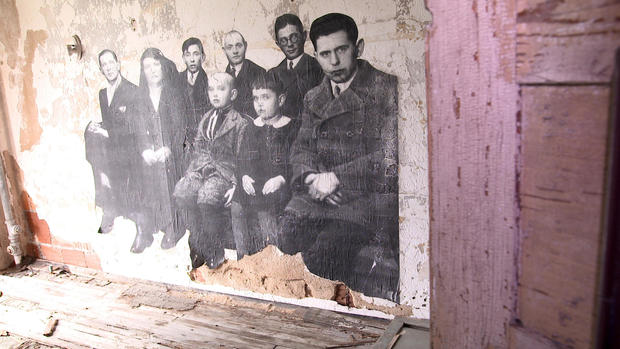The topic of immigration is currently a big discussion in United States political sphere with many people being apathetic about families being torn apart and pushing for harder immigration policies. Artists choose their medium and then use it as a way to give their interpretation about what is going on and to provoke emotion and curiosity of the spectator.
 |
| Photos in JR's exhibition in Ellis Island |
In 2015, TedPrize winning artist JR created a photography installation at New York's Ellis Island in regards to immigration. He showed the world the stories of the people who went through Ellis Island. His photography exhibit also reminded me of Shimon Attie's Berlin exhibit The Writing on the Wall in which Attie projected pre-World War II photographs of Jewish street life in Berlin onto the same or nearby addresses.
 |
| Shimon Attie The Writing on the Wall |
Tillie and Israel (The parents of my grandmother on my mother's side) escaped from Aulonov, Russia in 1920. They went by horse to Romania, from there to Antwerp and then to Liverpool England eventually the boarded a ship to Halifax Canada. They left Russia due to the horrible Antisemitism they encountered. Tillie was a maid for her step mother’s sister, according to Bobbie ( my grandmother Lillian) since the stepmother didn’t want her around. The aunt and her children, all except one son, wanted to leave Russia. So Israel went in the brother’s place. My great grandparents were married in Winnipeg in 1921. They went to Winnipeg since the aunt's husband was already there and had sent the tickets. In Russia, Israel was a grain merchant. When he first went to Winnipeg, he was a junk merchant trying to make as much as he could until he met someone who taught him to be a baker. He later went on to own his bakery with a partner, but according to my grandmother, the partner stole all the money, so they went bankrupt. He later worked for a large bread baking company where he died in 1942 in an "industrial accident" which we are not sure if it was an accident or if he was pushed as an act of antisemitism.
On my father's side, there was some absence when it came to the Holocaust and the European front. Growing up I did not know much about my grandfather because he died while I was 12. At 13, the age of my Bat mitzvah, I started to become interested in the Holocaust and my relationship because I was required to read the Diary of Anne Frank. I never really got to ask him many questions about his past. My grandfather himself had already been in the United States pre- World War Two but most of his family was from Lithuania and Poland and thus perished at the hands of the Nazis.
Instead of having the usual high school graduation trip (or even walking at my graduation) I ended up in Lithuania to see where my family came from. Darbenai is in the Kretinga district of Lithuania, north of the resort town Palanga and just a few miles from the Baltic coast. According to the locals, just before WWII most of the 708 residents were Jews. While driving through Lithuania, we stopped to try and talk to some locals to find out where the synagogue was and the cemetery, whether maybe that they had heard stories about my family or knew of someone who lived in the town. All of a sudden this drunk guy hops into our minivan and tells us where to drive and that he will be out translator since the "old man doesn't speak English." Once we arrived and knocked on the door, this 4 foot 11, toothless man came out. Throughout the translations, we learned that he was the current groundskeeper of the old Jewish cemetery and that he knows where all of the mass graves of the Jews are located. He also told us that many people don't know about these mass graves and that in the last five years we were the first to want to see it and to even take interest in this area. We got into the car, and we drove for 10 minutes into this forested area, and then hiked through it for another 30. Along the way, he told us stories of the Jews and the takeover of Poland by the Nazis and about his life, under Nazi rule and Soviet rule. He even showed us some photographs. Seeing where my family was from in Lithuania really put into perspective this idea that everyone has some form of story in regards to immigration.
More information on JR's Art:
Artist's hidden message on Ellis Island| 60 Minutes | Video
Gallery: Why the stories of Ellis Island matter today
More information on Shimon Attie:
Shimon Attie
No comments:
Post a Comment